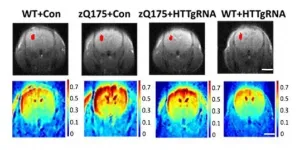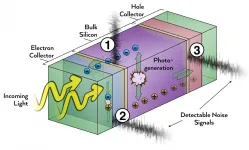(Press-News.org) Dutch-French research shows that Optical Genome Mapping (OGM) detects abnormalities in chromosomes and DNA very quickly, effectively and accurately. Sometimes even better than all existing techniques together, as they describe in two proof-of-concept studies published in the American Journal of Human Genetics. This new technique could radically change the existing workflow within cytogenetic laboratories.
Human hereditary material is stored in 46 chromosomes (23 pairs). Although those chromosomes are quite stable, changes in number or structure can still occur. A well-known example is Down syndrome, which is caused by an extra chromosome 21 (trisomy 21). An extra chromosome makes a big difference and is quite easy to visualize. But all kinds of other, smaller changes can occur as well in chromosomes. Sometimes pieces of DNA are lost (deletions), sometimes a piece is just repeated (duplication) or it is moved to another place (translocation). An existing piece can also be turned over (inversion) and sometimes new pieces are inserted (insertions). All these structural abnormalities in the chromosomes can cause disease, either congenital genetic diseases, which are present from birth, similar to Down syndrome, or acquired disorders, when the change occurs in a few cells during life which can lead to cancer, such as in leukemia.
Optical Genome Mapping
Cytogenetics is the genetic discipline that examines chromosomes for such abnormalities. To visualize both the large and small changes, several complementary techniques are needed, such as FISH, karyotyping and Copy Number Variant (CNV) microarrays. These are often laborious techniques that individually can only visualize a part of the above-mentioned abnormalities. Recently a new technique has become available - Optical Genome Mapping - which more or less brings together the previous techniques. But new techniques must prove themselves in practice. At Radboud University Medical Center (Radboudumc), Alexander Hoischen, associate professor of Genomics Technologies and Immuno-Genomics, researches new techniques for usability in clinical research and possibly later in patient care. It requires close cooperation between Radboudumc and the industry involved in building latest genomic technologies, in this case the America-based company Bionano Genomics.
Two advantages
Hoischen immediately mentions two major advantages of OGM: "We can now look at extremely long stretches of DNA, so there's fewer pieces needed to map the entire chromosome. It's faster and produces fewer errors. Furthermore, unlike the other techniques, we do not have to pre-process or manipulate the DNA, so we look at the real, 'natural' DNA. In short: what you see is what you get."
Automatic, objective, digital
Bionano has created a label that attaches to a specific piece of DNA that occurs very often, but irregularly. The ever-changing distances between the labels create a unique barcode so researchers always know exactly where they are situated in the DNA. This labeled DNA is pulled through thin long nanochannels, while a camera continuously takes pictures. Hoischen: "In this way we can automatically, objectively and digitally record DNA at a rapid pace, and at a resolution that is 10,000 times higher than in karyotyping. It's a kind of 'cytogenetics on steroids' because of its power and speed."
Hereditary disorders
But how well does the technology work? Two papers in the American Journal of Human Genetics give a positive answer. Dr. Laïla El Khattabi of the Université de Paris, Alexander Hoischen, and their colleagues, tested OGM on 85 samples from patients with a hereditary disorder that had previously been examined with the standard tests (karyotyping, FISH, CNV microarray). Remarkable and exceptional: OGM found them all. El Khattabi: "OGM can really revolutionize the detection of chromosomal aberrations. I think it could be the most significant technological breakthrough in the history of cytogenetics since the CNV microarray."
Early adapters
In the second paper, the team of Nijmegen researchers again compared the technique to the standard tests. This time they looked at the DNA of leukemia cells of 52 patients with leukemia, a hematological malignancy. Here too, OGM performed optimally by detecting all clinically known deviations. And even more than that. In a number of cases, the technique provided better and more accurate analyzes of chromosomal abnormalities. This is rather important, because the right treatment often depends on this. Hoischen: "We are early adapters of different genome technologies, often with the aim of quickly applying them routinely in the clinic. The very convincing data in these two proof-of-concept studies again place Radboudumc at the forefront of technical innovation for healthcare in human genetics. This 'Next Generation Cytogenetics' could replace decade old routine testing, vastly improving workflow and patient care." This is echoed by Dr. Marian Stevens-Kroef, Clinical Laboratory Geneticist for hematological malignancies: "OGM promises to greatly improve cytogenetic testing in patients with hematological malignancies."
Further roll out
Radboudumc researchers Dr. Kornelia Neveling and Dr. Tuomo Mantere, first authors in both studies, are also positive about the technique. Neveling: "It is a rather simple technology, for both the wet lab and data analysis, and we foresee great advantages for a use in a clinical setting. In addition, OGM has already helped to solve several medical mysteries, some of which have been waiting for answers for more than 20 years."
Tuomo Mantere, former postdoc in Alexander Hoischen's laboratory and now affiliated with Oulu University in Finland: "The easy implementation of this technique and the convincing concordance with the standard cytogenetic methods as presented in these two studies convinced me to set up OGM now in Finland as well."
INFORMATION:
*Paper in AJHG: Next generation cytogenetics: comprehensive assessment of 52 hematological malignancy genomes by optical genome mapping - Kornelia Neveling, Tuomo Mantere, Susan Vermeulen, Michiel Oorsprong, Ronald van Beek, Ellen Kater-Baats, Marc Pauper, Guillaume van de Zande, Dominique Smeets, Daniel Olde Weghuis, Marian JPL Stevens-Kroef, Alexander Hoischen
*Paper in AJGH: Optical genome mapping enables constitutional chromosomal aberration detection - Tuomo Mantere, Kornelia Neveling, Céline Pebrel-Richard, Marion Benoist, Guillaume van der Zande, Ellen Kater-Baats, Imane Baatout, Ronald van Beek, Tony Yammine, Michiel Oorsprong, Daniel Olde-Weghuis, Wed Majdali, Susan Vermeulen, Marc Pauper, Aziza Lebbar, Marian Stevens-Kroef, Damien Sanlaville, Jean Michel Dupont, Dominique Smeets, Alexander Hoischen, Caroline Schluth-Bolard, Laïla El Khattabi
A decade's worth of data shows that neonatologists are shifting the type of respiratory support they utilize for preterm infants, a move that could lead to improved health outcomes.
Using two large national datasets that included more than 1 million preterm infants, researchers in a new Vanderbilt-led study found that from 2008 to 2018 there was a greater than 10% decrease in the use of mechanical ventilation for this patient population. Concurrently, there was a similar increase in the use of non-invasive respiratory support, such as continuous positive airway pressure (CPAP), for these infants.
The ...
(Boston)--The discovery of novel groups or categories within diseases, organisms and biological processes and their organization into hierarchical relationships are important and recurrent pursuits in biology and medicine, which may help elucidate group-specific vulnerabilities and ultimately novel therapeutic interventions.
Now a new study introduces a novel computational methodology and an associated software tool called K2Taxonomer, which support the automated discovery and annotation of molecular classifications at multiple levels of resolution from high-throughput bulk and single cell 'omics' data. The study includes a case ...
SILVER SPRING, Md.--Vaccines such as Pfizer, Moderna, Johnson & Johnson and AstraZeneca are designed to prevent severe Coronavirus-19 Disease (COVID-19) due to acute respiratory syndrome coronavirus 2 (SARS-CoV-2) and are highly efficacious. The efficacy is not different in people with and without obesity except for AstraZeneca which is not known, according to a new position statement from The Obesity Society (TOS), the leading scientific membership organization advancing the science-based understanding of the causes, consequences, prevention and treatment of obesity.
Trials have demonstrated high efficacy in individuals ...
In a new study on mice, Johns Hopkins Medicine researchers report that using MRI scans to measure blood volume in the brain can serve as a noninvasive way to potentially track the progress of gene editing therapies for early-stage Huntington's disease, a neurodegenerative disorder that attacks brain cells. The researchers say that by identifying and treating the mutation known to cause Huntington's disease with this type of gene therapy, before a patient starts showing symptoms, it may slow progression of the disease.
The findings of the study were published May 27 in the journal Brain.
"What's exciting about this study is the opportunity to identify a reliable biomarker that can ...
Hamilton, ON (July 7, 2021) - A McMaster University team of researchers recently discovered how, exactly, the COVID-19 vaccines that use adenovirus vectors trigger a rare but sometimes fatal blood clotting reaction called vaccine-induced immune thrombotic thrombocytopenia or VITT.
The findings will put scientists on the path of finding a way to better diagnose and treat VITT, possibly prevent it and potentially make vaccines safer.
The researchers' article was fast-tracked for publication today by the prestigious journal Nature in its accelerated article preview because of the importance of the research.
"Our work also answers important ...
A genetic map of an aggressive childhood brain tumour called medulloblastoma has helped researchers identify a new generation anti-cancer drug that can be repurposed as an effective treatment for the disease.
This international collaboration, led by researchers from The University of Queensland's (UQ) Diamantina Institute and WEHI in Melbourne, could give parents hope in the fight against the most common and fatal brain cancer in children.
UQ lead researcher Dr Laura Genovesi said the team had mapped the genetics of these aggressive brain tumours for five ...
Some exceptionally gifted people have marked human history and culture. Leonardo, Mozart, and Einstein are some famous examples of this phenomenon.
Is talent in a given field a uniquely human phenomenon? We do not know whether gifted bees or elephants exist, just to name a few species, but now there is evidence that talent in a specific field exists, in at least one non-human species: the dog.
A new study, just published in Scientific Reports, found that, while the vast majority of dogs struggle to learn object labels (such as the names of their toys), when tested in strictly controlled conditions, a handful of gifted word learner ...
As society moves towards a renewable energy future, it's crucial that solar panels convert light into electricity as efficiently as possible. Some state-of-the-art solar cells are close to the theoretical maximum of efficiency--and physicists from the University of Utah and Helmholtz-Zentrum Berlin have figured out a way to make them even better.
In a new study, physicists used a technique known as cross-correlation noise spectroscopy to measure miniscule fluctuations in electrical current flowing between materials inside silicon solar cells. The researchers identified crucial electrical ...
Nature has a vast store of medicinal substances. "Over 50 percent of all drugs today are inspired by nature," says Gisbert Schneider, Professor of Computer-Assisted Drug Design at ETH Zurich. Nevertheless, he is convinced that we have tapped only a fraction of the potential of natural products. Together with his team, he has successfully demonstrated how artificial intelligence (AI) methods can be used in a targeted manner to find new pharmaceutical applications for natural products. Furthermore, AI methods are capable of helping to find alternatives to these compounds that have the same effect but are much easier and therefore cheaper to ...
Researchers at the IBS Center for Quantum Nanoscience at Ewha Womans University (QNS) have shown that dysprosium atoms resting on a thin insulating layer of magnesium oxide have magnetic stability over days. In a study published in Nature Communications they have proven that these tiny magnets have extreme robustness against fluctuations in magnetic field and temperature and will flip only when they are bombarded with high energy electrons through the STM-tip.
Using these ultra-stable and yet switchable single-atom magnets, the team has shown atomic-scale control of the magnetic field within ...






